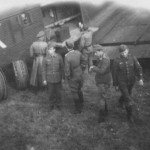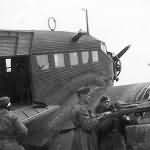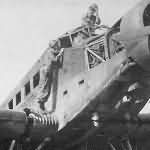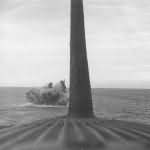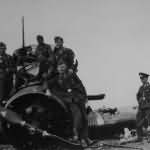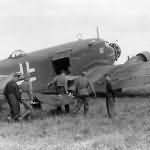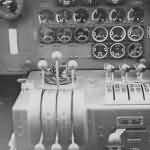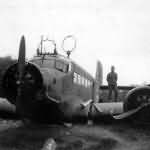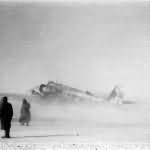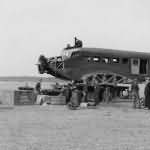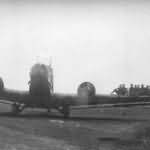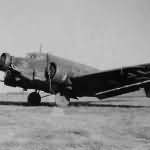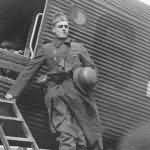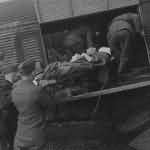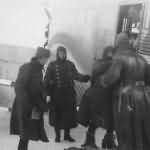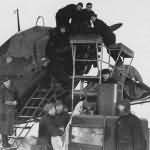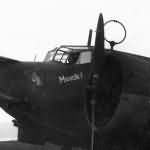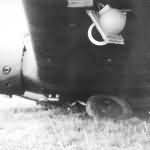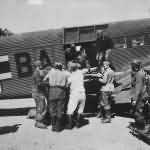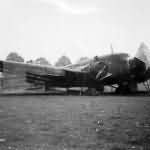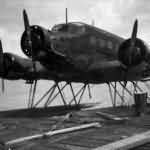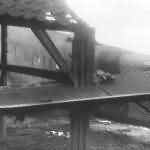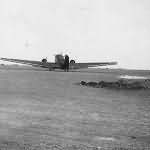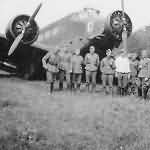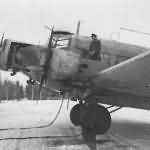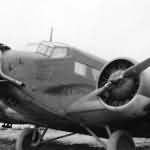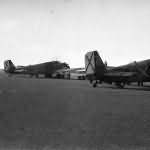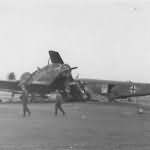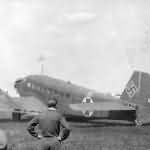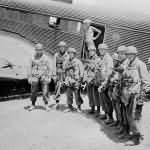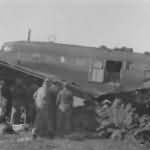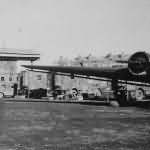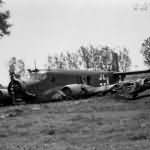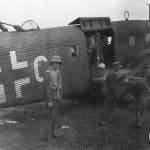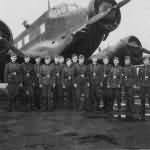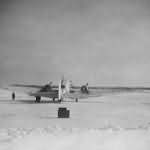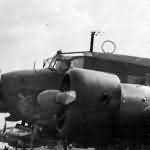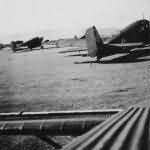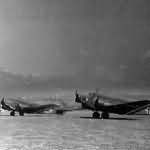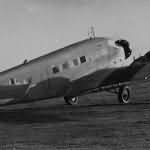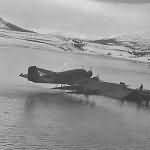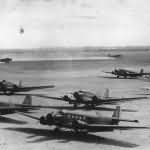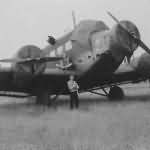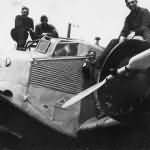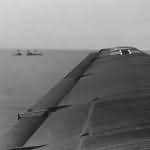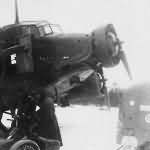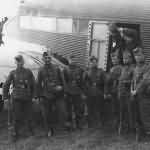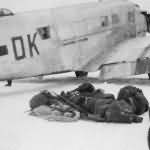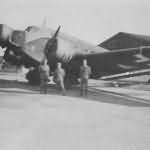Junkers Ju 52 43 4V+AH
Junkers Ju 52 8T+DN Transportgeschwader 2
German Ju 52/3m g3e coded 22+90 of the Legion Condor
Junkers Ju 52/3m coded 9P+BL of the 3./KGrzbV 9, May 1941 2
Junkers Ju 52 1Z+DU France 1940
Junkers Ju 52 3m NJ+KO III.KGrzbV 700 1942 Russia
Junkers Ju 52 3m 1Z+J
Junkers Ju 52 N3+ I.KGzbV 172
Junkers Ju 52 1Z+BA Fallschirmjager Crete Malemes 1941
Junkers Ju 52 3m VB+IS 1940 41 France
Junkers Ju 52 BJ+
Junkers Ju 52 3m KD+IG KGrzbV 500 1942
Junkers Ju 52 3m 9P+BL 3.KGrzbV 9 May 1941
Junkers Ju 52 3m Transportgeschwader 1 1Z+AC
Junkers Ju 52 +KH
Junkers Ju 52/3m coded “1Z+EK” of the 2/KGzbV 1 on the ground
Junkers Ju 52 front view
Junkers Ju 52/3m just before landing in North Africa
Junkers Ju 52/3m code 8H+T?
Junkers Ju 52 transport aircraft
Junkers Ju 52 converted into a medical evacuation aircraft
US soldiers examines the wreckage of a Junkers Ju 52/3m
Junkers Ju 52 3m Mienensuchgruppe of Luftwaffe
Luftwaffe soldiers poses atop a destroyed Ju 52/3m
Loading wounded soldiers into a Ju 52/3m g4e, France June 1940
The cockpit interior of the Junkers Ju 52/3m
German soldiers inspecting a crashed Junkers Ju 52/3m g3e, 1940-41
Junkers Ju52 lands at Amsterdam-Shipol, Holland 1941
Junkers Ju 52 9
Junkers Ju 52 belly landing
Junkers Ju 52 3m Messina 1943
Floatplane Ju 52/3m in flight over Greece, 1942-1943
Refueling for an Junkers Ju 52/3m “Tante Ju” in 1941
Junkers Ju 52/3m g3e crashed near Arras, France 1940
Junkers Ju 52 16
Captured Junkers Ju 52 “Tante Ju” Salzburg Austria 1945
Junkers Ju 52 Pitomnik STALINGRAD January 1943
Ex-civilian Junkers Ju 52 3m in Luftwaffe service, 1940-1941
Junkers Ju 52 3m 12
Junkers Ju52
Late ex-bomber Junkers Ju 52/3m g3e on the ground
Junkers Ju 52 Crete Greece 1941
Junkers Ju 52 3
Stretchers were loaded on board through the hatch-way
Nieman R 10 and Ju 52 at a captured Soviet airfield
Junkers Ju 52 Transportgeschwader 3
Junkers Ju 52 main landing gear, 1941. Other trimotors in the background
Pre-warming of the engines of Junkers Ju 52 in winter
Junkers Ju 52/3m of the KGrzbv 500, on the snow-covered airfield
Junkers Ju 52 Muschi
Junkers Ju 52 Rotterdam May 1940
captured Ju52
Crashed trimotor Junkers Ju 52/3m with black undersurfaces
Wounded are off-loaded from a Junkers Ju 52 MEDEVAC
Junkers Ju 52 crashed in Norway Stavanger Sola, 1940
Junkers Ju 52 top
A moored seaplane Junkers Ju 52/3m (See)
camouflaged Junkers Ju 52
Junkers Ju 52 eastern front winter camo
Floatplane Ju 52/3mg5e anchored on the water, France 1940
Junkers Ju 52 5
Junkers Ju 52 3m 2
Crashed Junkers Ju 52/3m. 1940
Junkers Ju 52 german transport aircraft
Ju52 Tranport Plane on airfield
Junkers Ju 52 3m 4
Flying minesweeper Junkers Ju 52/3m g7e MS in flight
Rotterdam Ju 52
Junkers Ju 52 3m winter camo 1943 1944
Wysoki rangą niemiecki oficer przed lotem Ju52/3m
German trimotor transport aircraft Junkers Ju 52/3m “Tante Ju”
Junkers Ju 52/3m of Legion Condor, San Sebastian, Spain
Junkers Ju 52 Luftwaffe 1942
Junkers Ju 52 3m tante ju
Junkers Ju 52 airfeld
destroyed Ju 52
Junkers Ju 52 3m 1940 Evreux
German Luftwaffe Ju52s sits on a grass airfield, soldiers in the foreground
Junkers Ju 52 18
Junkers Ju 52 near Arras France
Destroyed Ju 52 3m with its tail sheared off, 1940-1941
Junkers Ju 52 Medic Russia
Junkers Ju 52/3m crashed in the Alps, winter
Junkers Ju 52 and German paratroopers Fallschirmjäger
Junkers Ju 52 II.JG 2 Tunisia 1942
Completely destroyed transport aircraft Ju 52 3m, 1940-1941
Junkers Ju 52 15
Heavily damaged Junkers Ju 52/3m after landing on a meadow in Holland, May 1940
Junkers Ju 52 3m 8
Junkers Ju 52/3m g10e After a supply flight to Crete
Junkers Ju 52 11
Junkers Ju 52 3m
Junkers Ju 52 winter camo
Junkers Ju 52 13
Junkers Ju 52 48
Ju 52s after the capture of Crete in 1941, “Operation Mercury”
Junkers Ju 52 sanitary transport
Junkers Ju 52 3m Transportgeschwader 1
Junkers Ju 52 planes
Junkers Ju 52 Catania Italy
tante ju Junkers Ju 52
Junkers Ju 52 Iron Annie
Junkers Ju 52 Kirkenes Norway
Junkers Ju 52 DAK Afrika 1941
Junkers Ju 52 3m 3
Junkers Ju 52 Floatplane Greece
Junkers Ju 52 26
Heavily damaged Junkers Ju 52/3m after landing on a meadow in France, 1940
Junkers Ju 52 21
Junkers Ju 52 3m over Mediterranean Sea
Junkers Ju 52/3m and fuel truck on the snow-covered airfield
Junkers Ju 52 50
Junkers Ju 52 Tante ju
Junkers Ju 52/3m code ?E+OK painted in winter camouflage
Junkers Ju 52 crashed after forced landing, PKW in the foreground
Junkers Ju 52 Iron Annie
The first Junkers Ju 52 was a single engined freighter, appearing in 1930. The more familiar trimotor Junkers Ju 52/3m appeared two years later, when large numbers were built for Lufthansa and foreign civil operators. They were first put to use by the new Luftwaffe as bombers when they formed the core of the heavy squadrons, and they were initially used in this role in the Spanish Civil War. However, with the arrival of more specialised bombing types, the Ju 52/3m was soon discarded as a bomber and turned into a military transport.
Although it was a “sitter” for fighters, and its losses were heavy, the Ju 52/3m was otherwise very successful in its new role and took part in invasions and advances by the Wehrmacht in many theatres of war, including Libya, Crete and the Low Countries. In April 1940 it figured in the first large-scale use of air transport in a war when it took part in the invasion of Norway. “Tante Ju”, as the Ju 52/3m was popularly known, remained in quantity production almost to the end of hostilities despite the emergence of several potential replacements.
Total production of the type, including a number built under licence in Spain and France, reached 4854 aircraft.
General Description
- Type: General purpose military transport, glider-tug, paratroop-carrier, and magnetic-mine sweeper.
Wings
- Configuration: Low-wing cantilever monoplane.
- Design:
- Middle portion integrated into the fuselage, forming its undersurface.
- Wings connected by Junkers screw couplings.
- Eight duralumin tube spars arranged in pairs vertically, braced with short struts.
- Corrugated metal skin provides torsional stiffness.
- Full trailing-edge flap for camber adjustment and lift increase; outer sections function as horn-balanced ailerons.
Fuselage
- Structure: Rectangular section with domed decking.
- Material: Composed of duralumin frames and bracing, with four longerons and a stressed skin of corrugated light-alloy sheeting.
Tail Unit
- Type: Normal monoplane with semi-cantilever tailplane.
- Design:
- Tailplane passes through the fuselage top and is braced underneath by single struts on each side.
- Elevator constructed with double-wing design, horn-balanced.
- Cantilever fin and horn-balanced rudder.
- All components have all-metal construction with corrugated metal covering.
- Tailplane is adjustable in flight.
Landing Gear
- Type: Divided type.
- Design:
- Half-axles and radius-rods hinged to the fuselage.
- Oleo-pneumatic shock-absorbers attached to the upper wing-root of the foremost spar.
- Compressed-air brakes.
- Option to replace wheels with twin single-step floats.
Power Plant
- Engines: Three BMW 132 A or T nine-cylinder radial air-cooled engines.
- Fuel Capacity: 535 Imperial gallons.
Accommodation
- Cockpit:
- Enclosed pilot’s cockpit above and forward of the wing.
- Side-by-side seating with dual controls.
- Radio operator can be seated in the pilots’ compartment or near window gun mountings.
- Troop Capacity: Cabin accommodates 16-18 fully-armed troops or can be fitted for twelve stretcher cases.
Armament
- Configuration: Guns mounted in various positions, including forward fuselage, dorsal, lateral, or ventral positions.
- Typical Armament:
- One dorsal 13 mm MG 131 machine gun.
- Two lateral 7.9 mm MG 15 machine guns.
Dimensions
- Span: 95 ft. 10 in. (29.25 m).
- Length: 62 ft. (18.9 m).
- Height: 14 ft. 10 in. (4.5 m).
- Wing Area: 1,190 sq. ft. (110.5 sq. m).
Weights
- Empty Weight: 14,325 lbs. (6,510 kg).
- Maximum Take-off Weight: 24,200 lbs. (10,990 kg).
Performance
- Maximum Speed: 165 mph (264 km/h) at sea level.
- Cruising Speed: 132 mph (211 km/h).
- Climb to 10,000 ft (3,050 m): 17 minutes.
- Service Ceiling: 18,000 ft. (5,490 m).
- Range with Maximum Fuel: 800 miles (1,280 km).














